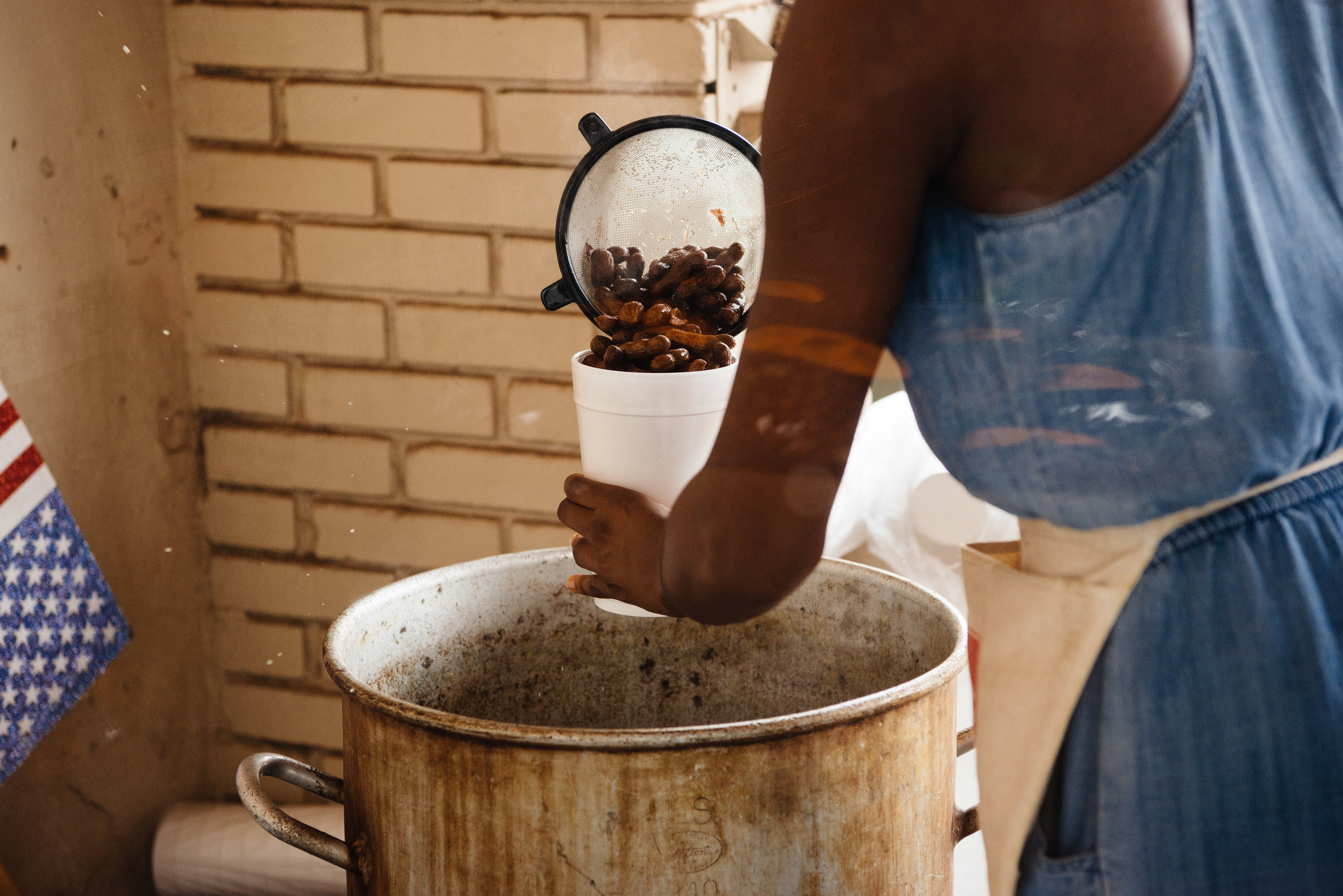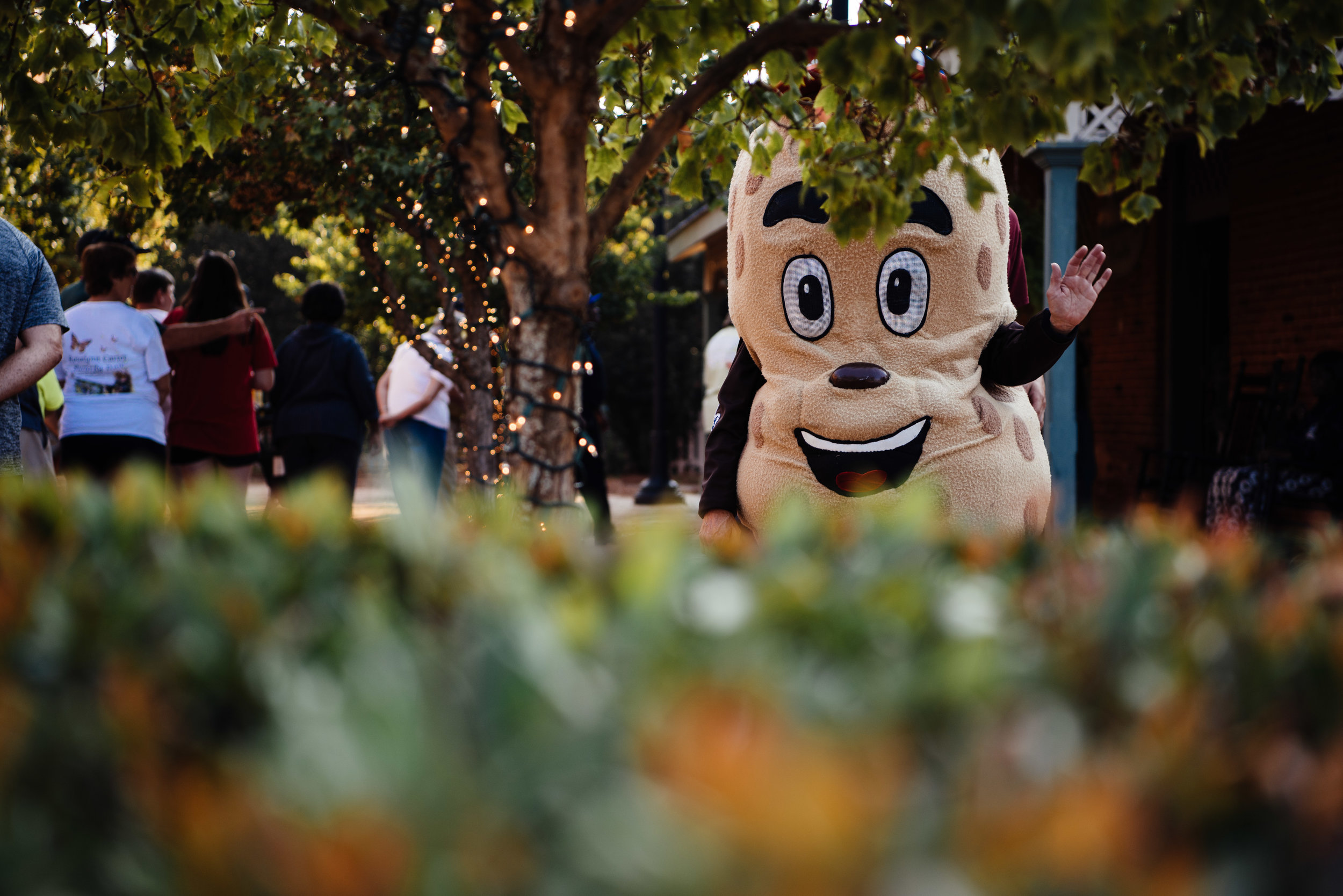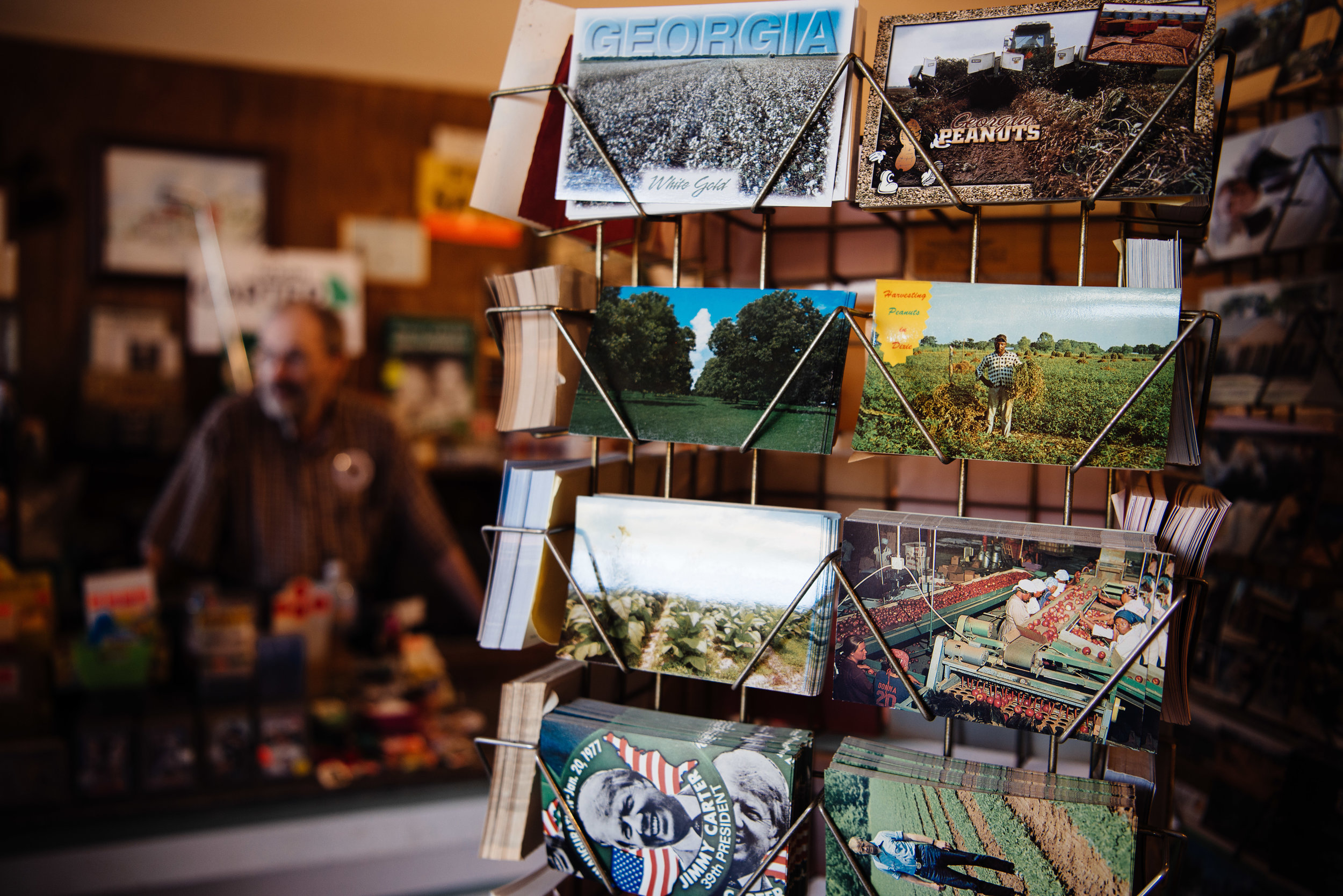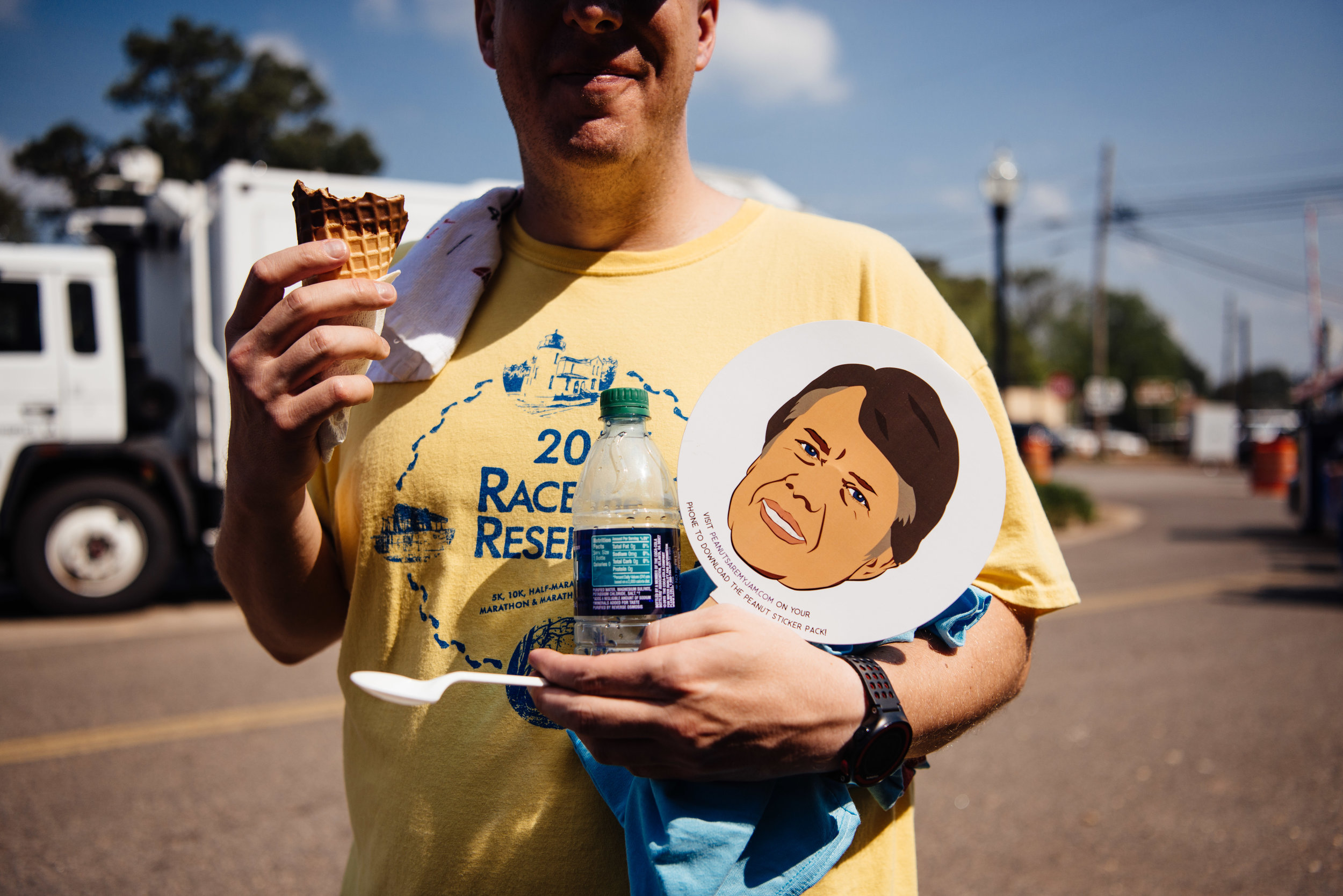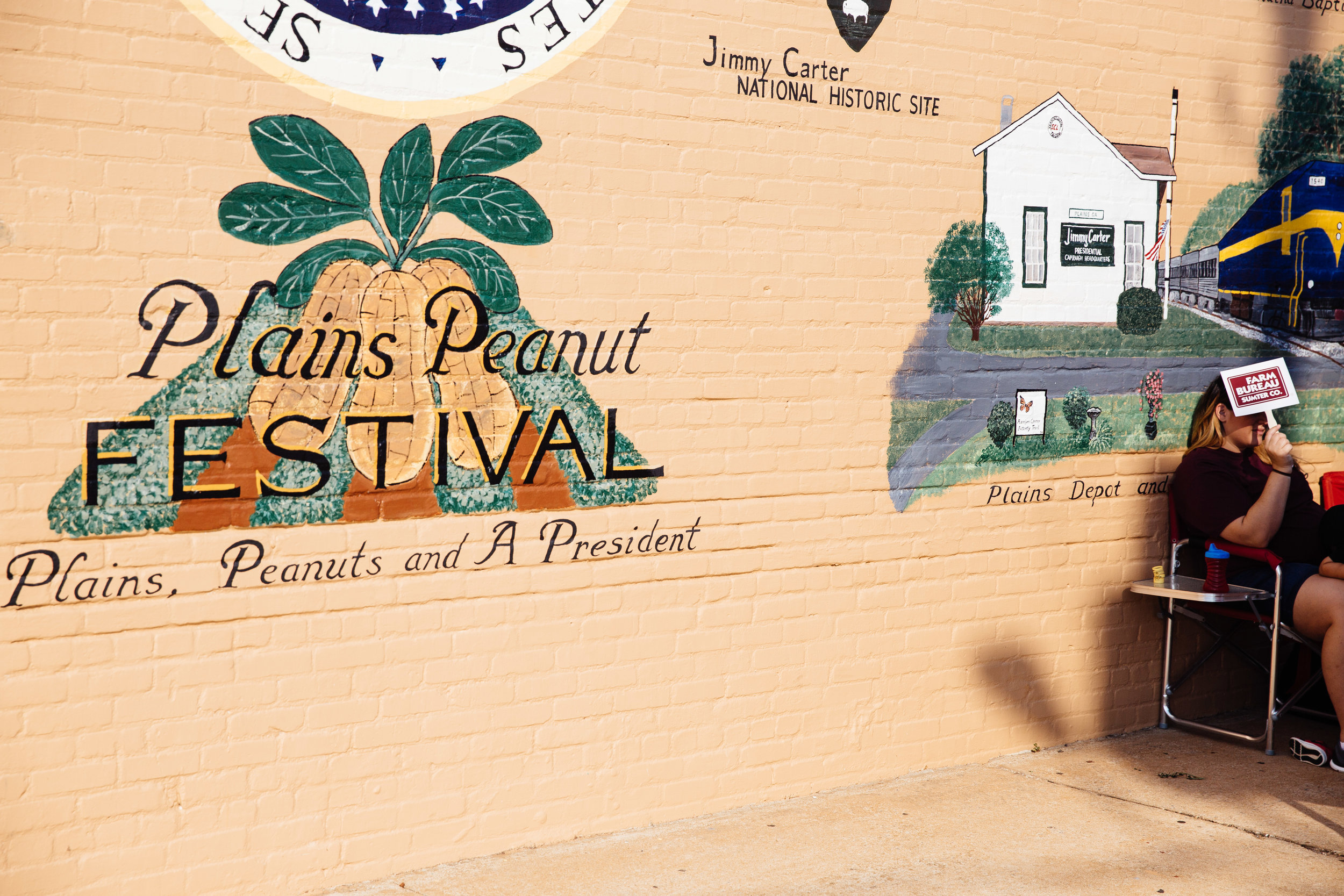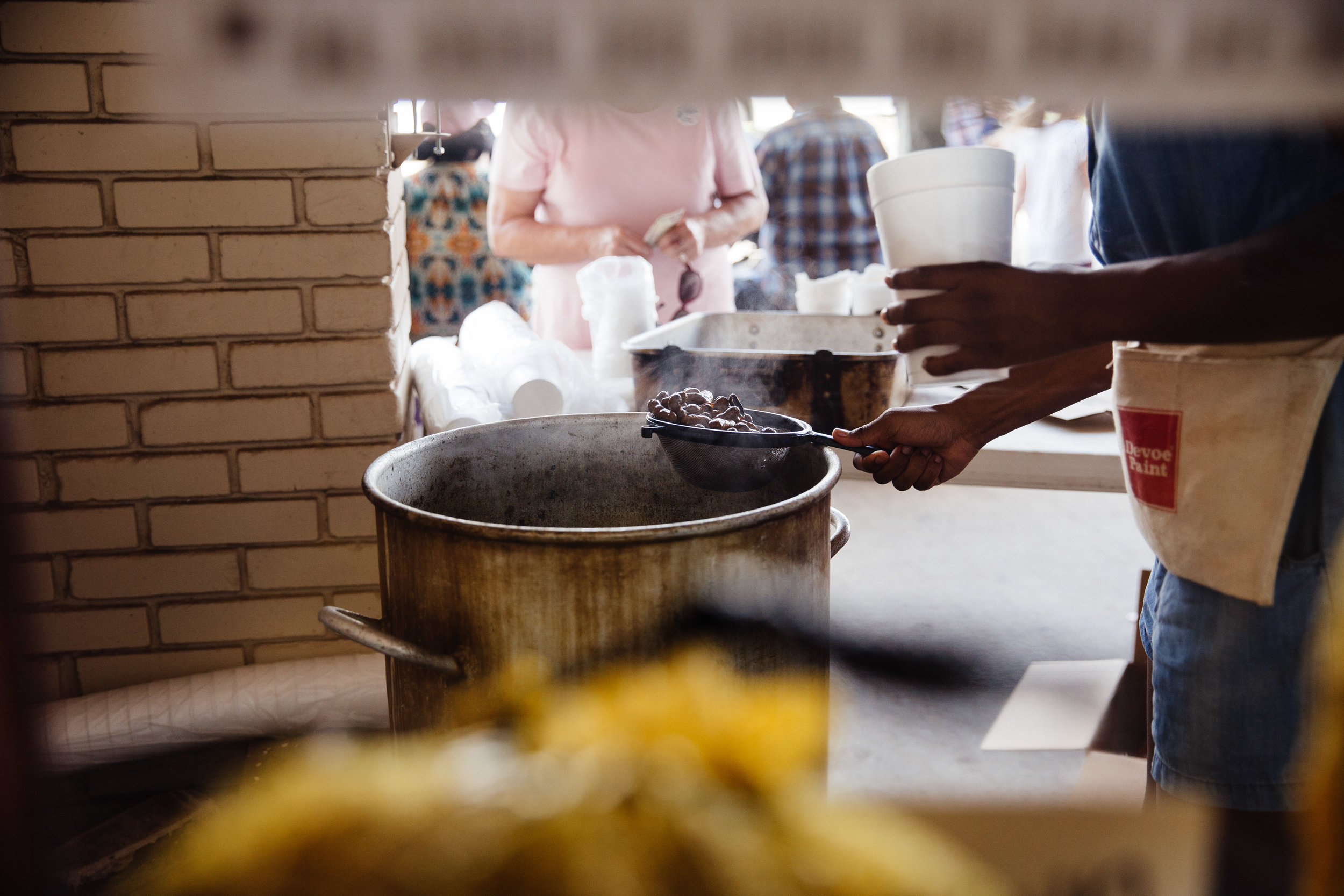Peanuts are essential to tailgate parties, baseball games, political rallies, school lunches, state fairs, circuses, and even prison commissaries. But only in the South do we truly love them boiled.
March 13, 2018
“Stop the car,” I shouted. “Pull over now. Now!”
We were driving on a county road near the Georgia border. My husband, Bronson, startled, swerved to the shoulder, and I flung open the passenger door to run back to a makeshift stand — two sawhorses, a plank, and a pot—tended by an old man sitting in a lawn chair under a live oak.
Returning to the car, I offered the soggy paper sack.
''What...?''
''Just try them,'' I said. “Stick one in your mouth.”
''They look disgusting. Don't let that drip on the mat.''
Bronson is from New Jersey. I watched him cautiously shell and eat his first boiled peanut.
“Oh, my God.''
“See?''
That was 25 years ago. And we’re still married.
Boiled peanut vendor, Plains, Georgia.
The peanut belongs to the New World, but it’s a long journey from genesis to a boiled peanut stand in Georgia. Somewhere in the Bolivian Andes, two wild plant ancestors cross-pollinated 10,000 years ago to create the hybrid cultivar Arachis hypogaea, a scientific reference to how this weedy member of the legume family grows under the earth. From its center of origin, cultivation spread into Brazil, Argentina, Peru, Mexico, and the Caribbean; when the Portuguese and Spanish arrived, colonists added it to their pantries as well. In 1570, explorer and naturalist Gabriel Soares de Souza noted cooks in Bahia had begun to exchange peanuts for Old World nuts in recipes “cut and covered with a sugar mixture as confections … candied and cured in long thin pieces.” Portuguese traders subsequently introduced the peanut to their colony in China, now the world’s biggest producer, and also ports in West Africa, where indigenous cousins, especially the Bambara groundnut, or Vigna subterraneana, were already a subsistence crop.
And this is where the history of the peanut turns ugly: It was a provision on slave ships plying the Middle Passage, which is how it eventually arrived in the South. Known to Kongo speakers as nguba or mpinda, these root words evolved into “goober” and "pindar” when enslaved African-Americans subsequently planted them in their colonial kitchen allotments. In “Notes on the State of Virginia,” Thomas Jefferson documented the cultivation of peanuts there by 1781 — he planted 65 hills of “peendars” and remarked during his presidency they were very sweet. Henry Wansey, a member of the Bath and West of England Agricultural Society, ate roasted nuts on his tour of America in 1794. He is credited with the first located use of the word “pea-nut.” During the Denmark Vesey Conspiracy of 1822 in Charleston, a conjurer named Gullah Jack was reported to instruct superstitious plotters to eat parched corn and groundnuts, and carry a crab claw in their mouths as an amulet for invulnerability. Confederate troops ate them as an emergency ration. Consequently, the goober pea song. The sheet music first printed by a Confederate sympathizer is jokingly credited to A. Pindar (words) and P. Nutt (music).
Peanuts have become an aspect of our intangible cultural heritage, essential to tailgate parties, baseball games, political rallies, school lunches, state fairs, circuses, and even prison commissaries. Roasted, parched, buttered, and raw. Only in the South do we truly love them boiled. Slippery on the outside, chewy in the pod. Those who slurp oysters raw but think “country caviar” tastes like snot? Shame on you. My father loved eating them with a Grape Nehi, but I prefer an ice-cold Coke, with enough throat-choking fizz to kill down the salt. Unlike my husband, I don’t recall eating my first boiled peanut but haven’t forgotten the outrage when vendors first introduced unorthodox flavorings to the brine. Cajun spice? Old Bay? BBQ rub? (More recently, Atlanta-based chef Asha Gomez, who wrote “My Two Souths,” posted about adding turmeric and Serrano peppers to the brine, and I can’t stop thinking about it.) Boiled peanuts always seemed within reach during my childhood summers, at the height of the harvest, when stands spontaneously popped up on the two-lane highways of the Peanut Belt.
“It’s serendipitous,” said Matt Lee, of the Lee Bros. Boiled Peanut Catalog. “Never know when you’ll come across a good one.”
Alex Hardy remembered his grandfather plowing fields with a mule. A rawboned man in his late 60s, he surveyed row after row of peanut vines as a harvester churned past, uprooting the late season crop with a little shimmy to shake off the sandy Georgia soil. A tractor followed, pulling a combine that threshed the nuts and spewed out chaff. The swirling dust was ballet-slipper pink. Hardy’s wife, Jacque, a retired studio photographer, picked up a handful of green nuts left on the ground and cracked them open.
“At one time, Alex’s granddaddy had a stable of 38 mules,” she said.
“They were a prized possession,” he said, nodding. “Couldn’t do without them. My daddy had a mule for a year or two but quickly switched to tractors once he got out the war.”
Hardy’s ancestors migrated to Pulaski County, Georgia, in the late 18th century, and for generations have farmed at the tail end of the Atlantic Coastal Fall Line, the geologic boundary where the outwash plain of the upper continental shelf deposited sandy, loamy soil, which happens to be paradise for raising peanuts, give or take a bankrupting drought. The lesser roads in this part of the state are lined with pecan groves and loblolly pine. Before forced onto the Trail of Tears, the Creek Confederacy had its capital here; Sherman’s March to the Sea passed to the north. And the extended Hardy family currently owns one of the larger peanut operations in south Georgia, which includes an oil-roasting plant and a packing warehouse. They also farm 1,000 acres of peanuts. More than half are green nuts selected for boiling.
“Our first year, we planted three acres,” said Hardy. “That yielded 10,000 pounds. Sold them in gallon buckets and trash bags. Now we’re up to a million pounds.”
Alex Hardy at work in one of his peanut fields.
We climbed back into Hardy’s pickup and drove to the warehouse, a red-trimmed, metal-sided facility on U.S. Highway 341, close by the family farmhouse and an artificial lake where the grandchildren fished until an alligator interloped. Nuts from the field wagons were being loaded into bulk containers, then passed through a cleaning system and tumbled along conveyor belts as contract workers processed them, picking out stray stems and imperfect pods. (Seasonal employees are bused in daily from Americus, an hour and a half away. The break room has signs in English and Spanish.) Forklifts moved pallets of bushel bags into cold storage. Most of the green harvest would be shipped to Southern supermarket chains like Kroger and Winn-Dixie, or picked up by wholesale distributors with customers farther north.
“We send one or two semi loads a day to New York, and it all winds up in Chinatown,” said Hardy. “Chinese, Africans, Indians. They might not cook them the way we do, but it's a good market. A guy originally from Gambia buys them for Minnesota. We also pack out a one-ounce size; you know, the kind on airplanes, for colleges and farm organizations. And a two-ounce size, believe it or not, for the prison system.”
Cleaning and processing peanuts at Hardy Farms.
Peanuts are a singularly Southern crop because they need 140 frost-free days to mature. They are historically grown in fields from Virginia to Texas, and more recently are expanding into Arkansas and southern Missouri. Seedsman John Coykendall is even spreading the gospel of Bambara groundnuts in Tennessee. But Georgia remains the epicenter of peanut farming.
Hardy explained that the four commercial cultivars are Spanish, Valencia, Runner, and Virginia. (He grows Jumbo Georgia Runners.) “We’ve got 25 roadside stands and sell the Runners there. They are the preferred flavor for the connoisseurs and those who have the palate and know the difference. We’ve tried the Virginias, but customers will turn around and walk off.”
We passed through plastic curtains into the boiling room, where his nephew Ken Hardy supervised the steam kettles. Measuring bowls brimmed with spice mix. Brining salt was piled against the wall. Ken boiled them at home, too. Adding ham hocks to the brine for flavor was his next day-off project.
“A peanut will not take in the salt until the heat’s turned off,” he said. “I’ve wanted to try this with ham hocks at home, but I need pantyhose to put them in, and my wife won’t give me a pair.”
His uncle smiled.
“In 1991, we decided to add on value to the crops we were growing,” Hardy said. “We couldn’t get boiled peanuts the way we liked them, fresh out of the field. The green peanut is bright and pretty and has sweetness to it. They’re harvested before full maturity and still at the tender stage.”
“When do you eat boiled peanuts, and what do you drink with them?” I asked.
“Usually watching the game,” he said. “Best to me? Beer. Otherwise, Coke.”
Hardy enters the boiling room, where the goobers are hot and wet.
Since I was driving deeper into Georgia that night, we went into nearby Hawkinsville for lunch at a cafeteria opposite the train tracks. The Hardys greeted neighbors at other tables, and then heaped their plates with fried chicken, stewed tomatoes, and collards from the buffet. Dessert was yellow sheet cake with peanut butter caramel icing. A waitress brought over a pitcher of sweet tea. Hardy removed his AgGeorgia Farm Credit gimme cap and placed a paper napkin on his lap.
“Peanuts, to me, that’s the perfect food,” he said. “They say with water and a piece of bread and peanut butter you can live.”
Jacque refilled my tea glass.
“Like every Southern town, you never go the ball game of any sort that you don't see peanut hulls everywhere,” she said. “And yesterday, in the next county, we went down there with a little wagon and gave away peanuts at a fundraiser boil for Lt. Gov. Casey Cagle.”
Hardy walked over to the cash register to pay for lunch. I asked how he felt about the season ending.
“More glad than sad. I’m ready for a break. It’s so demanding.”
Jacque chimed in.
“We have a little boy at church, he’s probably 5, you never see him but he says, ‘When are the peanuts going to be gone? I hate to see them leave. Tell me they’re going to be around for a bit longer.’”
We headed back to their farmhouse. Jacque tapped me on the shoulder and pointed out the truck window to an unexceptional meadow surrounded by oaks.
“As we’re passing, see that monument in the yard? Confederate president Jefferson Davis camped right there the night before he was captured by northern soldiers.”
Actually, he still owns it.
Plains is even smaller than Hawkinsville, with a population of 683, including the two who require a permanent Secret Service detail posted outside their white clapboard house. On the outskirts of town, a grain silo complex, cotton warehouse, and transfer station for peanut wagons are clustered. Main Street consists of two commercial blocks and is bisected by a rail line, which passes next to the whistle-stop depot that served as the 39th president’s campaign headquarters.
Every September, Plains celebrates the peanut harvest with parade floats and a road race. A peanut princess is crowned. Concession stands sell funnel cakes and shaved ice. The Carters sign books at the antique store. In the account of his childhood, “An Hour Before Daylight,” Carter writes:
I began selling boiled peanuts on the streets of Plains when I was five years old. This was my first acquaintance with the outside world. As soon as the nuts began to mature on the vines, I would take my little wagon into one of the fields nearest our house, pull a load of peanut vines out of the ground, carry them home, pick the peanuts off the vines, wash them, and soak them in salty water overnight. The next morning, as early as possible, I boiled the peanuts for a half-hour or so until they were cooked but still firm, filled about twenty half-pound paper sacks (forty on Saturdays), and carried them to town in a basket, either walking down the railroad tracks or riding on my bike.
Scenes from the Plains, Georgia, Peanut Festival
By the time I arrived, one morning after eating green nuts in the Hardy’s fields, the parade was long over and the Nobel Prize laureate away from home. I bought a bag of boiled Georgia Runners and a used copy of “The Carter Family Favorites Cookbook” (1977) in a gift shop. A chapter is devoted to peanut recipes: peanut butter brownies, peanut praline cakes, bacon and peanut butter cornbread, peanut vegetable loaf, peanut butter fondue. The high school Jimmy Carter and his wife Rosalynn attended has been converted to a museum and contains memorabilia from their childhood and political campaigns. The grinning peanut logo — based on Carter’s own generous smile — is singularly weird. On display in a hall are peanut drawings by schoolchildren who have visited the National Historic Site.
More compelling is the Jimmy Carter Boyhood Farm, a few miles outside of town in the rural community of Archery, named for a 19th-century relief organization of the African Methodist Episcopal Church. Originally the modest house lacked running water and electricity, and the family cook prepared meals on a wood-fired stove. The dining room table was set with plastic replicas of fried chicken, deviled eggs, iced tea — a homespun reminder of how the Carters would eventually entertain in a bigger white house. The kitchen garden supplied the family with vegetables, and a dry goods store on the property operated by Carter’s father supplied the neighbors, predominantly black farmers, and railroad employees. Walking around the quiet yard gave me a better sense of how growing up on the farm shaped the president’s commitment to service, starting with early morning chores and his first commercial venture as a boiled-peanut vendor.
While Carter served in the Oval Office, he placed the family businesses into a blind trust to avoid conflict of interest. (How times have changed.) An Atlanta lawyer named Charles Kirbo was appointed financial trustee. Suffice to say, he did not do well by Jimmy Carter. After three years of drought and mismanagement, the plain-speaking president left the White House over $1 million in debt and dangerously close to losing the family farm.
Carter saved the fields with a book deal and the sale of his family's processing plant. His life in public service extended beyond his term as president, most notably with the founding of the Carter Center, whose peace and health initiatives extend around the world. Even in his early 90s, he continues to volunteer with Habitat for Humanity, which has its headquarters in nearby Americus. But in 2013, the former leader of the free world admitted: "I'm a peanut farmer at heart, still grow peanuts on my farm in Georgia."
The Rev. Wayland Fuller Dunaway recorded a rare stanza of the Goober Pea song when confined at the Union prison on Johnson’s Island, Ohio, during the latter half of the Civil War. Dunaway was serving as a captain in Company I of the 40th Virginia Infantry when captured during the Battle of Falling Waters in July 1863. W. H. Shelton, an officer with the First New York Artillery, was incarcerated in 1864 but escaped from a Confederate prison camp in Columbia, South Carolina. As he fled toward Union lines, emancipated blacks offered him goobers to eat. In the account of his escape, he noted he was regularly provided "boiled peanuts, which was a favorite way of cooking when the bean was too green to bake." And in March of 1865, two months from surrender, Robert E. Lee was quoted as saying to his son, G.W. Custis Lee: “I have been up to see the Congress and they do not seem to be able to do anything except to eat peanuts and chew tobacco, while my army is starving.”
Peanuts keep showing up in dire circumstances, whether on slave ships or war zones because they are packed with protein and insanely nourishing. Bob Parker, president of the National Peanut Board, told me: “It’s the No. 1 food requested by food banks. When there is a natural disaster, we send peanut butter to those areas.” Parker cited Project Peanut Butter, of St. Louis, which produces and distributes RUTF [ready-to-use therapeutic food] peanut paste to combat child malnutrition in Ghana, Malawi, and Sierra Leone. He also referenced MANA, another peanut paste produced in Georgia, distributed by Unicef and other aid organizations.
“A one-ounce bag of peanuts will carry you a long time,” he said. “And peanut butter is in 94 percent of American pantries.”
George Washington Carver did not invent peanut butter. That’s one of those conflated facts taught in grade school, much like everyone still believing the earth was flat in the 15th century when Columbus discovered America. Actual first honors go to a Canadian, Marcellus Gilmore Edson, who was issued U.S. Patent No. 306727 for his “flavoring paste” to be used in the manufacture of “peanut-candy” on October 21, 1894. (Pre-Columbian Aztecs also pounded peanuts into a paste, so nothing is really new in the New World.) But Carver’s botanical research at the Tuskegee Institute contributed greatly to peanut butter’s rise in popularity. In 1916, he published a bulletin titled "How to Grow the Peanut & 105 Ways of Preparing It for Human Consumption," which included his recipes for soup, cookies, fudge, and mock chicken. He also recommended peanuts for shampoo, mayonnaise, paint, massage oil, and flour. The Carvoline cosmetics company of Birmingham manufactured peanut hair pomade with his endorsement.
It is unlikely Carver would have imagined the use devised more recently by 12 inmates at Walker County Jail in Jasper, Alabama, on a Sunday evening last July. They saved peanut butter from their sandwiches and molded it like clay to alter a number above a door leading outside, then tricked a rookie guard into opening it. (The employee thought he was letting them back into the cells.) The prisoners ditched their orange jumpsuits, flung blankets over the razor wire fence, and busted out. Most didn’t get far—two were captured at the Flying J truck stop in town. At a news conference the next day, county Sheriff James E. Underwood said:
“Changing some numbers on the door with peanut butter — that may sound crazy, but these people are crazy like a fox.”
When I reached Jasper Mayor Paul Liollio for comment, he wrote back: “This wasn't Jasper's finest hour.”
Nat Bradford tipped a pail of Carolina African Runners into the blast path of an industrial fan, scattering chaff and dust and twigs on his driveway. His farm also lies near the Fall Line, in Sumter, South Carolina, about 275 miles northeast from the Hardy’s spread in Hawkinsville. Here the loamy soil is military tan, the fields of soy and cotton are fronted by evangelical churches, and small white crosses marking traffic accidents sprout next to kudzu-smothered fire hydrants. Thunderclouds were stacked in the distance, promising relief from the scorching upcountry heat, but the swarming gnats were relentless whenever Bradford shut off the fan to inspect the odd little nuts piling up in a plastic tub.
“It’s an old, persnickety heirloom,” he said, adjusting his tiger orange Clemson University visor. An eighth-generation farmer, the 43-year-old landscape architect specializes in growing persnickety crops on 10 acres. For the past two years, he has battled drought stress, late spring frosts, thrips, weed competition, and tomato spotted virus to grow this bijou peanut organically. (It’s one-quarter the size of a Virginia Jumbo.) Now he is experimenting with threshing and winnowing techniques to prevent losing a huge percentage of his yield.
“The last time this nut was harvested? It was done by hand in the 1920s. It’s not suited to modern-day, mechanized farming,” he said, waving toward the scant bag at his feet. “But I’d rather have all my peanuts here than scattered on the field. Last year I was out there with a rake and a leaf blower, figuring out how to get them. And when you turn those peanuts over and the deer find them, they’ll put a hurt on them, so you don’t want them to sit long.”
Bradford is one of the seedsmen working to revive Arachis hypogea v. carolina african. Listed in the Slow Food Arc of Taste, this foundation variety is thought to have arrived by slave ship at the end of the 17th century, and raised by enslaved Africans in the West Indies and the South, essentially returning full circle a landrace cultivar to native soil. According to the entry: “Its original culinary uses were greatly inflected by West African practices: The nuts were boiled, ground into meal for fritters, candied, mashed and decocted into a hot beverage, roasted, and pressed into oil.”
These were likely the goober peas of song and story.
One of my favorite narratives about the Carolina African Runner involves the “maumas” of Charleston, free black women who peddled a peanut-and-molasses candy known as groundnut cake. Sold for a penny, it was a humble treat that transitioned from the street to grander kitchens on the peninsula. Sarah Rutledge listed two recipes in “The Carolina Housewife” (1847), one of which has a close resemblance to the candy observed by Soares de Souza in colonial Brazil more than two centuries earlier. In her influential Reconstruction-era recipe collection, “Mrs. Hill’s New Cook Book” (1872), Annabella P. Hill, who lived through the Civil War in LaGrange, Georgia, not too far north of Plains, has a recipe for ground pea candy that resembles taffy, with additions of coconut and almonds. Earlier versions included egg whites, brandy, and lemon peel.
Few in living memory recall what groundnut cake tastes like, as the Charleston vendors were shut down before the Depression, and the Carolina African Runner nearly vanished as larger cultivars prevailed. Until five years ago, a remaining handful of stock sat dormant in a seed bank at North Carolina State University. Its comeback is credited to the persistence of horticultural preservationists at Clemson’s Coastal Research Center. Reviving groundnut cake is the present and parallel task of culinary historians like Gullah chef Benjamin “BJ” Dennis, who sat with me at a picnic table outside Rodney Scott’s BBQ in North Charleston before I drove upcountry to Sumter.
“We’ve still got the same palate as our ancestors,” he said. “True Gullah Geechee food is really more related to what you see in West Africa. Those candies were molasses-based, that was the dominant sweetener, fresh ground from the sugar cane. But it can overwhelm. You want to taste that peanut. Those are the characteristics we’re still trying to recreate.”
Dennis’ roots research took him to the southernmost Caribbean.
“The story got deeper when I went to Trinidad, and saw toolum, monkey meat, and groundnut cake candies being sold there,” he said. “It was interesting talking to people in the West Indies and looking back at desserts from West Africa. It seemed like a typical dessert of the diaspora.”
“How do you eat boiled peanuts?” I asked.
“I treat my peanuts like a bean, not cooked to mush, gotta have a little bite, salt, and chili flake. If I dump them over the sink into a strainer, I don’t usually leave the sink. They don’t last long.”
Talking with Dennis reminded me of another cultural link buried in the chapter on Brazil in Vertamae Smart-Grosvenor’s “Vibration Cooking or the Travel Notes of a Geechee Girl”: “Bahia lies one thousand miles north of Rio and thirteen degrees south of the equator. … Everything was everything I had dreamed of and more. Bahia felt like home. It was South Carolina and Africa.”
When Bradford finished winnowing, the two of us went back out in the field. We stopped at a drying shed where several wagons parked. He had me climb up the side and stick my nose in the one containing his Carolina African Runners. The aroma nearly knocked me to the ground. It smelled like childhood.
“It’s the tastiest peanut I’ve eaten,” said Bradford.
“This is your whole crop?”
“We may get 3,200 pounds if everything is firing on all cylinders, but we’re already a foot in the hole because plants don’t even want to look at processing less than several 18-wheelers at a time. Might take a while to crack that nut.”
Bradford scooped out several more bushel bags.
“If we can scale it up, I think this nut has a really good chance of getting out of the niche market. That’s my dream, to have a wagon full one day. Not the bottom of a wagon.”
“What’s your favorite way to eat peanuts?”
“Boiled. If you can harvest them young, they are juicy and the shells are so thin you can eat the whole peanut. I like mine to be a little spicy, Cajun style. And I’m definitely a beer person. Really start to hanker for those dark beers, porters and stouts, this time of year. Oh, my word.”
Bradford’s oldest son needed a ride to a football game, an hour away, and I was mindful of driving back to Charleston with late-season thunderheads in my way. He gave me a bag of nuts to carry away.
“How many kids?” I asked.
“Got five kids,” he said. “That’s four generations in a row with four boys and a girl. Think maybe it’s terroir. If it has an effect on food and plants, why wouldn’t it have an effect on us?”
“Could you please stop making a big mess?”
My husband surveyed our kitchen with dismay. A dozen cookbooks lay open, peanut shells scattered, a precious cup of Bradford’s Carolina African Runners parched in a cast iron skillet. The groundnut candy recipe in “The Carolina Housewife” requires boiling the mixture over a slow fire. How to interpret that? And the parched nuts: skins on or off? Mindful of the conversation with Benjamin Dennis, I substituted Sapelo Purple Ribbon cane syrup for harsher molasses. (It has a parallel history to the Carolina African Runner, but more about that another time.) Dennis is right to want this precious nut dominant.
“Want to try one?” I asked, offering a plate of the cooled candies.
“I don’t want to loosen my fillings,” Bronson replied.
“Oh, come on.”
My Jersey boy bit into one cautiously. I waited.
“Well, so what does it taste like?”
“Peanuts.”




